Sharp EL-738 User Manual
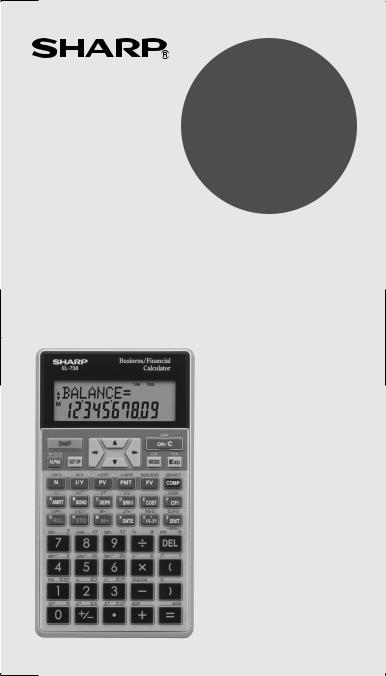
MODEL
EL-738
BUSINESS/FINANCIAL CALCULATOR
OPERATION MANUAL

NOTICE
•SHARP makes no guarantee that this product or this manual is suitable or accurate for any purpose, commercial or otherwise.
•Rules and practices in financial calculation vary according to country, locality, or financial institution. It is the consumer’s responsibility to determine whether or not the results produced by this product conform to applicable rules and regulations.
•SHARP will not be liable nor responsible for any incidental or consequential economic or property damage caused by misuse and/or malfunctions of this product and its peripherals, unless such liability is acknowledged by law.
•The material in this manual is supplied without representation or warranty of any kind. SHARP assumes no responsibility and shall have no liability of any kind, consequential or otherwise, from the use of this material.
•SHARP assumes no responsibility, directly or indirectly, for fi nancial losses or claims from third persons resulting from the use of this product and any of its functions, the loss of or alteration of stored data, etc.
•SHARP strongly recommends that separate permanent written records be kept of all important data. Data may be lost or altered in virtually any electronic memory product under certain circumstances. Therefore, SHARP assumes no responsibility for data lost or otherwise rendered unusable whether as a result of improper use, repairs, defects, battery replacement, use after the specified battery life has expired, or any other cause.
For Australia/New Zealand only:
For warranty information please see www.sharp.net.au
1

Contents |
|
Introduction.................................................................. |
3 |
Operational Notes ............................................................... |
3 |
Key Notations in This Manual.............................................. |
4 |
Chapter 1: Getting Started.......................................... |
5 |
Preparing to Use the Calculator.......................................... |
5 |
Resetting the Calculator In Case of Diffi culty...................... |
5 |
Calculator and Display Layout............................................. |
6 |
The SET UP Menu.............................................................. |
8 |
Operating Modes .............................................................. |
10 |
Chapter 2: General Information................................ |
11 |
Basic Calculations............................................................. |
11 |
Clearing the Entry and Memories ..................................... |
11 |
Editing and Correcting an Entry ........................................ |
13 |
Memory Calculations ........................................................ |
14 |
Chapter 3: Financial Functions ................................ |
17 |
General Information .......................................................... |
17 |
TVM (Time Value of Money) Solver .................................. |
22 |
Amortization Calculations ................................................. |
33 |
Discounted Cash Flow Analysis........................................ |
37 |
Bond Calculations ............................................................. |
44 |
Depreciation Calculations ................................................. |
48 |
Conversion between APR and EFF .................................. |
51 |
Day and Date Calculations................................................ |
52 |
Percent Change/Compound Interest Calculations ............ |
54 |
Cost/Sell/Margin/Markup Calculations .............................. |
56 |
Breakeven Calculations..................................................... |
58 |
Chapter 4: Scientific Functions................................ |
60 |
Constant Calculations ....................................................... |
60 |
Chain Calculations ............................................................ |
60 |
Scientifi c Calculations ....................................................... |
61 |
Random Functions............................................................ |
62 |
Modify Function................................................................. |
63 |
Chapter 5: Statistical Functions............................... |
64 |
Statistical Calculations and Variables................................ |
67 |
Appendix .................................................................... |
72 |
Financial Calculation Formulas......................................... |
72 |
Statistical Calculation Formulas........................................ |
75 |
Errors and Calculation Ranges ......................................... |
76 |
Battery Replacement ........................................................ |
80 |
Priority Levels in Calculations ........................................... |
81 |
Specifi cations.................................................................... |
82 |
Index ........................................................................... |
83 |
2

Introduction
Thank you for purchasing a SHARP Business/Financial Calculator.
After reading this manual, store it in a convenient location for future reference.
•Display of examples shown in this manual may not look exactly the same as what is seen on the product. For instance, screen examples will show only the symbols necessary for explanation of each particular calculation.
•All company and/or product names are trademarks and/or registered trademarks of their respective holders.
Operational Notes
•Do not carry the calculator around in your back pocket, as it may break when you sit down. The display is made of glass and is particularly fragile.
•Keep the calculator away from extreme heat such as on a car dashboard or near a heater, and avoid exposing it to excessively humid or dusty environments.
•Since this product is not waterproof, do not use it or store it where fl uids, for example water, can splash onto it. Raindrops, water spray, juice, coffee, steam, perspiration, etc. will also cause malfunction.
•Clean with a soft, dry cloth. Do not use solvents or a wet cloth.
•Do not drop the calculator or apply excessive force.
•Never dispose of batteries in a fi re.
•Keep batteries out of the reach of children.
•This product, including accessories, may change due to upgrading without prior notice.
3
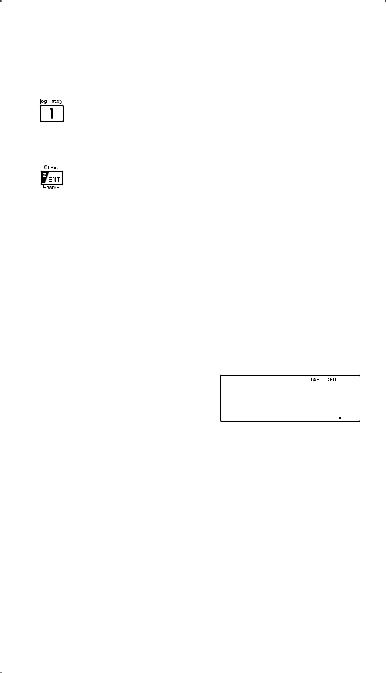
Key Notations in This Manual
Key operations are described in this manual as follows:
To specify log To specify 1 To specify Σxy
: .h..................... |
|
: 1or 1 ....................... |
|
: iV..................... |
|
To specify CLR-D: .?..................... |
|
|
To specify ENT |
: Q |
|
To specify Z |
: iZ..................... |
|
To specify DATA : J.............................. |
|
|
Functions that are printed in orange above the key require
.to be pressed fi rst before the key.
Number entry examples are shown with ordinary numbers (i.e., “100” will be indicated instead of “100”).
To specify a memory function (printed in green on/above the key), press ifi rst.
Functions that are printed in black adjacent to the keys are effective in specific modes.
 Using the .and ikeys
Using the .and ikeys
Press s.ti |
πA˚_ |
Ax,10. |
|
• .tand iA |
-10 |
|
|
mean you have to press . |
|
followed by )key and i |
|
followed by *key. |
|
Notes:
•The multiplication instruction “×” and alphabetic letter “X” are distinguished as follows:
|
|
Key Display |
Multiplication instruction |
→ x × |
|
Alphabetic letter |
→ X X |
|
•Examples in this manual are performed using default settings (e.g., SET UP menu items) unless values are otherwise assigned.
4

Chapter 1
Getting Started
Preparing to Use the Calculator
Before using your calculator for the first time, you must reset (initialize) it.
Resetting the calculator
Press the RESET switch located on the back of the calculator with the tip of a ball-point pen or similar object. Do not use an object with a breakable or sharp tip.
• After resetting the calculator,
the initial display of the NOR- |
000 |
|
MAL mode appears. |
||
|
Resetting the Calculator In Case of Difficulty
Caution:
The RESET operation will erase all data stored in memory and restore the calculator’s default setting.
In rare cases, all the keys may cease to function if the calculator is subjected to strong electrical noise or heavy shock during use. If pressing any of the keys (including s) has no effect, reset the calculator.
Resetting the calculator
See the above procedure.
Note: Pressing .kand 1=will also erase all data stored in memory and restore the calculator’s default setting.
5
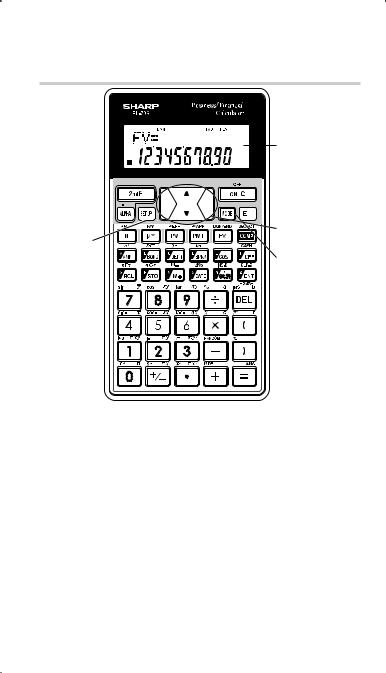
Calculator and Display Layout
Calculator layout
Key 


 operation
operation 



 keys
keys 



SET UP key
Display screen
Power ON/OFF and Clear key
Cursor keys
MODE key
Display screen: The calculator display consists of a 12-char- acter dot matrix character line and a 12-digit 7-segment character line (10-digit mantissa and 2-digit exponent).
Power ON/OFF and Clear key: Turns the calculator ON. This key also clears the display. To turn off the calculator, press ., then c.
Key operation keys:
.: Activates the second function (printed in orange) assigned to the following key.
i: Activates the memory (printed in green) assigned to the following key.
SET UP key: Displays the SET UP menu to select the display notation, angular unit, depreciation method and date format.
Cursor keys: Move the cursor.
MODE key: Switches between NORMAL and STAT modes.
6

Display layout
 Symbol
Symbol
Equation/  variable name display
variable name display
Mantissa |
Exponent |
|
•During actual use, not all symbols are displayed at the same time.
•Only the symbols required for the operation being explained are shown in the screen examples of this manual.
|
: Appears when the entire equation cannot be displayed. |
|
Press g/ yto see the remaining (hidden) part. |
/ |
: Indicates that variables or data are present above/be- |
|
low the screen. Press z/ ito scroll up/down. |
2ndF |
: Appears when .is pressed, indicating that the |
|
functions shown in orange are enabled. |
HYP |
: Indicates that .]has been pressed and the |
|
hyperbolic functions are enabled. |
ALPHA: Indicates that i, gor fhas been pressed, and storing or recalling memory values or TVM solvers/statistics variables can be performed.
BGN |
: Indicates that calculations are annuity due (payment |
|
at the beginning of each interval) calculations. When |
|
BGN is not displayed, calculations are ordinary annu- |
|
ity (payment at the end of each interval) calculations. |
360 |
: Indicates that date calculations are based on a |
|
360-day year (12 months with 30 days). When 360 is |
|
not displayed, date calculations use the actual calen- |
|
dar. |
ENT |
: Indicates that a value can be assigned to the displayed |
|
variable using Q. |
COMP : Indicates that the displayed variable can be solved for by using @.
FLOAT A / FLOAT B / TAB / SCI: Indicates the notation used to display values. It can be changed in the SET UP menu.
7

DEG / RAD / GRAD : Indicates which angular units are in use. It can be changed in the SET UP menu.
: Appears when statistics mode is selected.
M: Indicates that a numerical value is stored in the independent memory (M).
: Indicates that the value of the displayed variable has not been calculated yet (for variables that can be calculated).
The SET UP Menu
Press ~to display the SET UP menu.
 DSP DRG DEPR →
DSP DRG DEPR →  DATE
DATE
0 1 2 i 3
•A menu item can be selected by:
•Using g/ yto select a number (the selected number will blink), then pressing =, or
•pressing the number key corresponding to the menu item number.
•If or is displayed on the screen, press zor ito view the previous/next part of the menu.
•Press sto exit the SET UP menu.
Selecting the display notation and number of decimal places
The calculator has three display notation systems (fixed decimal point, scientific notation and floating point) for displaying calculation results.
•If ~00(TAB) is pressed, “DIG(0-9)?” will be displayed and the number of decimal places can be set to any value between 0 and 9.
•If ~01(SCI) is pressed, “SIG(0-9)?” will be displayed and the number of significant digit can be set to any value between 0 and 9. Entering 0 will set a 10-digit display.
•If a floating point number does not fit in the specified range, the calculator will display the result in scientific notation (exponential notation). See the next section for details.
•The default setting is a fixed decimal point with two decimal places.
8

Selecting the floating point number system in scientific notation
The calculator has two settings for displaying a floating point number:
FLO_A (FLOAT A) and FLO_B (FLOAT B). In each display setting, a number is automatically displayed in scientific notation outside the following preset ranges:
•FLO_A ~02: 0.000000001 ≤ | X | ≤ 9,999,999,999
•FLO_B ~03: 0.01 ≤ | X | ≤ 9,999,999,999
 Switching the notation setting
Switching the notation setting
Procedure |
Key operation |
Display |
|
100000 ÷ 3 = |
s100000 83 |
|
|
Fixed decimal point |
= |
|
1—————©3= |
with two decimal |
|
|
|
|
|
3333333 |
|
places |
|
|
|
→Scientific notation |
~01 |
2 |
1—————©3= |
(SCI) with two |
|
|
|
|
|
33 04 |
|
significant digits |
|
|
|
→Floating point |
~02 |
|
1—————©3= |
(FLO_A) |
|
|
3333333333 |
|
|
|
|
3 ÷ 1000 = |
s3 81000 |
3©1———= |
|
Floating point |
= |
|
|
|
0003 |
||
(FLO_A) |
|
|
|
→Floating point |
~03 |
|
3©1———= |
(FLO_B) |
|
|
3-03 |
→Fixed decimal point |
~00 |
2 |
3©1———= |
with two decimal |
|
|
|
|
|
000 |
|
places |
|
|
|
|
|
|
|
Selecting the angular unit (see page 61)
•DEG (°) : ~10(default setting)
•RAD (rad): ~11
•GRAD (g) : ~12
Selecting the depreciation method (see page 48)
•SL (Straight-line method): ~20(default setting)
•SYD (Sum-of-the-years’ digits method): ~21
•DB (Declining balance method): ~22
9
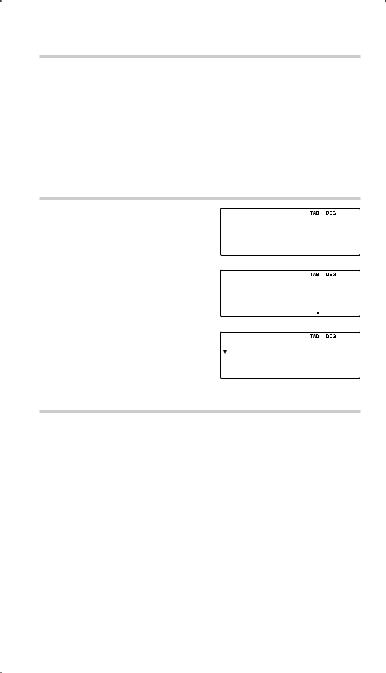
Selecting the date format (see page 44)
•US (Month-Day-Year): ~30(default setting)
•EU (Day-Month-Year): ~31
Operating Modes
This calculator has two operating modes, which can be selected using the MODE key.
Selecting a mode
1. Press m.
The menu display appears. NORMAL STAT
0 1
2. Press 0or =to se-
lect NORMAL mode.
000
•Press 1or y= to select STAT mode.
SD LINE QUAD
0 1 2
Operations available in each mode
NORMAL mode:
Allows you to perform financial, arithmetic, or scientific calculations.
STAT (statistics) mode:
Allows you to perform statistical, arithmetic, or scientific calculations. The  symbol appears in the display.
symbol appears in the display.
10

Chapter 2
General Information
Basic Calculations
Entering numbers and arithmetic operations
•Use the number keys 0to 9, decimal point key ., and sign change key ,to enter numbers into the calculator. To clear the display or entry, press s.
•Use the Skey to enter a value in scientifi c notation.
•Use the arithmetic keys +-x8to perform the standard arithmetic calculations of addition, subtraction, multiplication, and division. Press =to perform each calculation.
•Use the (and )keys to place parentheses around inner parts of expressions. The closing parenthesis )just before =or hmay be omitted.
•When you enter a series of operations in one sequence, the calculator performs the calculation according to the priority levels in calculation on page 81.
|
Example |
|
|
Key operation |
Result |
|||
45 |
+ 285 ÷ 3 = |
|
s45 +285 83 = |
14000 |
||||
18 |
+ 6 = |
|
(18 |
+ |
6 )8 |
343 |
||
15 |
– 8 |
|
(15 |
- |
8 = |
|||
42 |
× (–5) + 120 = |
42 x, |
5 +120 = |
-9000 |
||||
|
|
|
|
|||||
*1 (5 ,) |
*1 |
|||||||
|
|
|
||||||
|
3 |
–3 |
5 S3 84 S |
125000000 |
||||
(5 × 10 ) ÷ (4 × 10 |
) = |
,3 = |
|
|
||||
Clearing the Entry and Memories
The following methods of clearing the calculator (restoring default settings) are available:
11

|
Entry |
A-H, |
TVM |
Listed |
Cash |
|
Operation |
financial *3 flow |
|||||
(display) |
M, X-Z ANS |
variables*1 variables *4 data STAT *7 |
||||
|
|
|
|
|
|
|
s |
× × |
× |
|
× |
|
× |
× |
.b |
× |
× |
*2 |
× |
*5 |
× |
*6 |
m(Mode selection) |
× |
|
|
× *8 |
|||
.k0(MEM) |
|
|
|
|
|
|
|
.k1(RESET) |
|
|
|
|
|
|
|
RESET switch |
|
|
|
|
|
|
|
: Cleared or restored to the default setting |
×: Retained |
|
|
|
|||
N, I/Y, PV, PMT, and FV (P/Y and C/Y are not included.) Note that listed fi nancial variables sharing common memory with TVM variables, such as “COUPON (PMT)” used in bond calculations, are also cleared or restored to default settings. Listed variables used in fi nancial calculations (such as “RATE (I/Y),” etc.) including P/Y and C/Y
When you press *to enter a fi nancial calculation, AMRT P1 and AMRT P2 both revert to their default values. The same holds true for YEAR when you press O.
With one of the variables of a listed group (such as those used in bond calculations) displayed, when .bis pressed, all the variables in the listed group are cleared or restored to their default settings. Note that TVM variables sharing common memory with listed fi nancial variables are also cleared or restored to default settings.
*6 Press .bwhen a cash fl ow value is displayed. *7 Statistical data (entered data) and variables (n, x, etc.)
*8 Are cleared when changing between sub-modes in STAT mode.
Notes:
•To clear any of the “A-H, M, X-Z” or “ANS” memories, press sgand then specify the memory.
•To clear or restore to the default setting one variable or value of TVM variables, listed fi nancial variables, cash fl ow data, or STAT, refer to the relevant section.
•If you turn off the calculator (by pressing .cor by letting it turn itself off automatically), it will resume wherever you left off when you turn it on again.
Delete key
To delete a number/function, move the cursor to the number/ function you wish to delete, then press L. If the cursor is located at the right end of an equation or if you are entering a value, the Lkey will function as a back space key.
12

Memory clear key
Press . k to display the |
MEM RESET |
menu. |
|
• To clear all (A-H, M, X-Z, ANS, |
0 1 |
TVM variables, listed financial |
|
variables, cash flow data, and STAT), press 0 0 or
0 =.
•To RESET the calculator, press 1 0 or 1 =. The RESET operation erases all data stored in memory, and restore the calculator’s default settings.
Editing and Correcting an Entry
Cursor keys
•In a menu, such as the SET UP menu, use gor yto select a number (the selected number will blink), then press =. If you need to scroll up or down the screen, use z or i.
•In financial calculations, such as bond calculations, press i or z to move through the variables (items).
Playback function
After obtaining an answer, pressing gbrings you to the end of the equation and pressing ybrings you to the beginning. Press g or y to move the cursor. Press . g or
. y to jump the cursor to the beginning or end of the equation.
Insert and overwrite modes in the equation display
•This calculator has two editing modes: insert mode (default), and overwrite mode. Pressing . dswitches between the two modes. A triangular cursor indicates an entry will be inserted at the cursor, while the rectangular cursor indicates existing data will be overwritten as you make entries.
•To insert a number in the insert mode, move the cursor to the place immediately after where you wish to insert, then make the desired entry. In the overwrite mode, data under the cursor will be overwritten by the number you enter.
•This mode setting will be retained until you press . d or RESET the calculator.
13

 Changing “15 ÷ 3 =” into “25 ÷ 13 =”
Changing “15 ÷ 3 =” into “25 ÷ 13 =”
Procedure |
Key operation |
|
|
|
Display |
||
15 ÷ 3 = |
s15 83 = |
15©3= |
|
||||
|
|
500 |
|||||
|
|
|
|
|
|
|
|
Enter the playback |
y |
15©3 |
|
||||
function. |
|
|
|||||
|
|
|
|
|
|
|
|
|
|
|
|
|
|
|
|
Switch to overwrite |
.d |
|
|
15©3 |
|
||
|
|
||||||
mode. |
|
|
|
|
|
|
|
|
|
|
|
|
|
|
|
Change “15” to “25” |
2 yy |
25©3 |
|
|
|
||
and move the cur- |
|
|
|
|
|||
|
|
|
|
|
|
|
|
sor to “3”. |
|
|
|
|
|
|
|
|
|
|
|
|
|
|
|
Change to insert |
.d |
25©3 |
|
||||
mode. |
|
|
|
|
|
|
|
|
|
|
|
|
|
|
|
Change “3” to “13” |
1 = |
25©13= |
192 |
||||
and calculate. |
|
|
|
|
|
|
|
|
|
|
|
|
|
|
|
|
|
|
|
|
|
|
|
Errors
An error will occur if an operation exceeds the calculation ranges, or if a mathematically illegal operation is attempted. When an error occurs, pressing gor yautomatically moves the cursor to the place in the equation/number where the error occurred. Edit the equation/number or press sto clear the equation. For details, see page 76.
Memory Calculations
This calculator has 11 temporary memories (A-H and X-Z), one independent memory (M) and one last answer memory (ANS). It also has various variables for use in fi nancial calculations and statistical calculations.
Memory use in each mode for memory calculations
Mode |
A-H, |
TVM |
Listed financial |
Statistical |
X-Z M ANS |
variables*1 |
variables*2 |
variables *3 |
|
NORMAL |
|
× |
× |
× |
STAT |
|
× |
|
|
: Available |
×: Unavailable |
|
|
|
14

*1 N, I/Y, PV, PMT, FV
*2 All fi nancial variables, except for TVM variables
*3 x, sx, σx, n, Σx, Σx2, y, sy, σy, Σy, Σy2, Σxy, r, a, b, c
Temporary memories (A-H, X-Z)
Press gand the variable key to store a value in memory.
Press fand the variable key to recall a value from the memory.
To place a variable in an equation, press iand the variable key.
Independent memory (M)
In addition to all the other features of temporary memories, a value can be added to or subtracted from an existing memory value.
Press sgMto clear the independent memory (M).
Last answer memory (ANS)
•The calculation result obtained by pressing =or any other calculation ending instruction (including storing and recalling operations) is automatically stored in the last answer memory.
•Listed fi nancial variables are automatically stored in the last answer memory by displaying the variable and the value.
TVM variables
TVM variables can be recalled using fin the same way as temporary memories. It is not necessary to press gto store a value.
Listed financial variables
Financial variables are specifi c to the type of calculation they are used in. For example, the variable N is available to the TVM solver but not to discounted cash fl ow analysis calculations. If you want to carry a value from a variable over into a different type of calculation, use one of the following methods:
•Last answer memory (ANS): Within the original calculation, display the variable and value that you wish to carry over. The value is automatically entered into last answer memory. Press sto exit the calculation (the listed financial variables will disappear from the screen), and press i/to bring up the value from the previous calculation. M-D-Y (D-M-Y) 1 and M-D-Y (D- M-Y) 2 are not stored in last answer memory.
•Variables common to both calculations: If the value that you wish to carry over is held in a variable that exists in both types
15
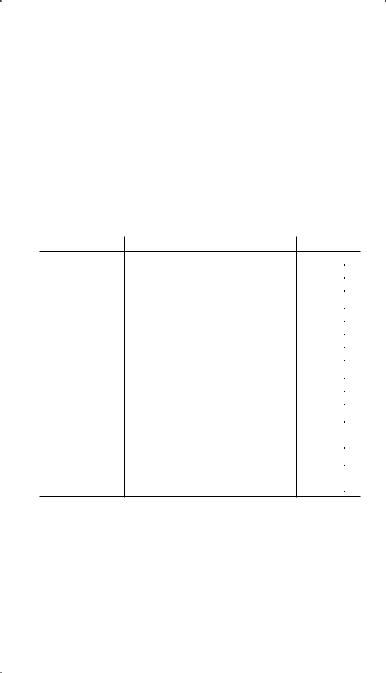
of calculation (for example, both bond calculations and the TVM solver use the variable I/Y), you can retrieve the value simply by switching calculation types and bringing up the variable.
Statistical variables
Statistical data is not entered into variables. Statistical variables are the results of the calculation of statistical data. Therefore, you cannot enter values directly into statistical variables. After calculation, however, you can use the values held in statistical variables in subsequent calculations.
Note: Use of for iwill recall the value stored in memory using up to 14 digits.
 Memory calculations
Memory calculations
Example |
Key operation |
Result |
24 ÷ |
(8 |
|
2) |
= |
s8 x2 gM |
1600 |
|||||||
× |
24 8iM= |
150 |
|||||||||||
|
(8 |
× |
2) |
× 5 = |
iMx5 = |
8000 |
|||||||
|
|
|
|
|
|
|
|
|
|
|
|||
|
|
|
|
|
|
|
|
|
|
|
|
|
|
|
$150×3:M1 |
sgM |
000 |
||||||||||
|
150 x3 h |
45000 |
|||||||||||
+)$250:M2=M1+250 |
250 h |
25000 |
|||||||||||
–)M2×5% |
fMx5 .% |
3500 |
|||||||||||
|
M |
|
|
|
|
|
|
||||||
|
|
|
|
|
|
|
.jfM |
66500 |
|||||
|
|
|
|
|
|
|
|
|
|
|
|||
|
|
|
|
|
|
|
|
|
|
|
|
|
|
$1 = ¥110 |
|
110 gY |
11000 |
||||||||||
¥26,510 = $? |
26510 8fY= |
24100 |
|||||||||||
$2,750 = ¥? |
2750 xfY= |
30250000 |
|||||||||||
r = 3 cm (r→Y) |
3 gY |
300 |
|||||||||||
πr2 = ? |
.tiY* |
|
|||||||||||
|
|
|
|
|
|
|
|
|
|
|
.;= |
2827 |
|
|
|
|
|
|
|
|
|
|
|
|
|
|
|
|
24 |
|
|
= 2.4...(A) |
24 8(4 +6 )= |
240 |
|||||||
4 + 6 |
3 xi/+60 8 |
||||||||||||
|
|
|
|
|
|
|
|||||||
3 × (A) + 60 ÷ (A) = |
i/= |
3220 |
|||||||||||
*Entry of the multiplication procedure is omitted between “π” and a variable.
16

Chapter 3
Financial Functions
General Information
Financial calculations
The following financial functions are available. Use NORMAL mode to perform financial calculations.
TVM (Time Value of Money) solver: Analyze equal and regular cash flows. These include calculations for mortgages, loans, leases, savings, annuities and contracts or investments with regular payments.
Amortization calculations: Calculate and create amortization schedules using values stored in the TVM solver.
Discounted cash flow analysis: Analyze unequal cash flows and calculate NPV (net present value) and IRR (internal rate of return).
Bond calculations: Solve bond prices or yields to maturity with accrued interest.
Depreciation calculations: Obtain depreciation base values using three types of calculation methods.
Conversion between APR and EFF: Interest rates can be converted between APR (annual, or nominal percentage rate) and EFF (effective interest rate).
Day and date calculations: Calculate dates and the number of days between dates.
Percent change/Compound interest calculations: Calculate percent change (increase or decrease) and compound interest rates.
Cost/Sell/Margin/Markup calculations: Calculate cost, selling price and margin/markup.
Breakeven calculations: Calculate breakeven points (quantity) using fixed costs, variable costs per unit, unit prices, and profit.
17

Variables used in financial calculations
Financial calculations use multiple variables. By entering known values into variables, you can obtain unknown values. Variables used in financial calculations are categorized into the following two types, depending on the entry method.
TVM variables:
Variables that are used in the TVM solver. These include N, I/Y, PV, PMT and FV. You can store, recall or calculate values directly using the corresponding keys.
Listed financial variables:
Variables that are organized into lists in different categories. These variables can be accessed using the z/icursor keys in each calculation. P/Y and C/Y in the TVM solver are of this type of variable.
Variables shared among calculations
Financial variables are specific to the type of calculation they are used in. Values are stored in these variables and recalled as required. Some variables are shared (in the memory area) among calculations. If you change the value of a variable in one calculation, the value will change in all the other calculations as well. The following list shows the variables shared between calculations. While calculating, be aware of the values stored in these variables.
TVM |
Discounted |
Bond |
Depreciation |
Percent change/ |
Day and date |
|
cash flow |
Compound inter- |
|||||
solver |
analysis |
calculations |
calculations |
est calculations |
calculations |
|
|
|
|
|
|
|
|
N |
— |
CPN/Y (N) |
LIFE (N) |
PERIODS (N) |
— |
|
|
|
|
|
|
|
|
I/Y |
RATE (I/Y) |
YIELD (I/Y) |
DB (I/Y) |
% (I/Y) |
— |
|
|
|
|
|
|
|
|
PV |
— |
PRICE (PV) |
COST (PV) |
OLD PRC (PV) |
— |
|
|
|
|
|
|
|
|
PMT |
— |
COUPON |
— |
— |
— |
|
(PMT) |
||||||
|
|
|
|
|
||
FV |
— |
REDEMPT |
SALVAGE (FV) |
NEW PRC (FV) |
— |
|
(FV) |
||||||
|
|
|
|
|
||
— |
— |
M-D-Y 1* |
— |
— |
M-D-Y 1* |
|
D-M-Y 1 |
D-M-Y 1 |
|||||
|
|
|
|
|||
— |
— |
M-D-Y 2 * |
— |
— |
M-D-Y 2 * |
|
D-M-Y 2 |
D-M-Y 2 |
|||||
|
|
|
|
*The variable names vary according to the data format settings.
18

Basic variable operations
TVM variables (N, I/Y, PV, PMT, FV)
A.Entering a value
Enter a value and then press the corresponding TVM variable key.
Note: You can also enter values into variables using arithmetic operations.
Ex. 100 x12 u
B.Displaying a value
Press fand the corresponding TVM variable key.
C.Executing calculation
Press @and the corresponding TVM variable key.
Listed financial variables
A.Entering a value
1.Select the desired financial calculation method by pressing the corresponding financial calculation key.
2.Use z/ito select the variable you wish to enter.
3.Enter the value and press Qwhen the “ENT” symbol appears.
Note: In step 3, you can also enter values into variables using arithmetic operations.
Ex. 100 x12 Q
B.Displaying a value
1.Use z/ito show the variable and value.
C.Executing calculation
1.Use z/ito select the variable you wish to calculate.
2.Press @when the “COMP” symbol appears.
Note: Pressing .bresets all the variables in the displayed listed financial group to the default values. For details, see the relevant sections for each financial calculation.
19

The ENT and COMP symbols
Listed financial variables are categorized by whether they are known or unknown. When the variable is selected (displayed), the “ENT” and/or “COMP” symbols will appear to indicate that the current variable may be entered (known variable) and/or calculated (unknown variable), respectively. For details, refer to the explanations or examples for each financial function.
Note: TVM variables (N, I/Y, PV, PMT and FV) can be entered (known variables) and calculated (unknown variables), however, neither “ENT” nor “COMP” will appear on the display.
Category |
Display symbols |
Descriptions |
|
|
ENT |
Variable can be used as |
|
For entry only |
a known, but not as an |
||
|
|
unknown. |
|
|
|
|
|
|
COMP |
Variable can be used as |
|
For calculation only |
an unknown, but not as |
||
|
|
a known. |
|
|
|
|
|
For entry or calcula- |
ENT COMP |
Variable can be used |
|
as either a known or an |
|||
tion |
|||
|
unknown. |
||
|
|
||
|
|
|
|
Calculated automati- |
|
Unknown variable, but |
|
— |
the calculator calculates |
||
cally |
|||
|
the value automatically. |
||
|
|
||
|
|
|
Notes:
•During financial calculation, the word “calculating!” will be displayed on the screen. You can press sat this time to cancel the calculation.
•Calculation-only and automatically calculated variables have no default values.
•The symbol will be displayed if the value of the displayed variable has not been calculated yet (for variables that can be calculated).
symbol will be displayed if the value of the displayed variable has not been calculated yet (for variables that can be calculated).
20

Compound interest
This calculator assumes interest is compounded periodically in financial calculations (compound interest). Compound interest accumulates at a predefined rate on a periodic basis. For example, money deposited in a passbook saving account at
a bank accumulates a certain amount of interest each month, increasing the account balance. The amount of interest received each month depends on the balance of the account during that month, including interest added in previous months. Interest earns interest, which is why it is called compound interest.
It is important to know the compounding period of a loan or investment before starting, because the whole calculation is based on it. The compounding period is specified or assumed (usually monthly).
Cash flow diagrams
The direction of arrows indicates the direction of cash movement (inflow and outflow) with time. This manual uses the following cash flow diagrams to describe cash inflows and outflows.
|
|
Present |
|||||||||
Inflow (+) |
value (PV) |
||||||||||
|
|
|
|
|
|
Time |
|||||
|
|
|
|
|
|
||||||
Cash |
|
|
|
|
|
|
|
|
|
|
|
flow |
|
|
|
|
|
|
. . . . . . |
|
|
||
|
|
|
Payment (PMT) |
|
|||||||
Outflow (–) |
|
|
|
|
|
|
|
|
Future |
||
|
|
|
|
|
|
|
|
|
|
value (FV) |
|
21

TVM (Time Value of Money) Solver
Analyze equal and regular cash flows. These include calculations for mortgages, loans, leases, savings, annuities, and contracts or investments with regular payments.
Note: Discounted cash flow analysis can be done using unequal cash flows (see page 37).
An amortization schedule can be calculated using the information stored in the TVM solver (see page 33).
Variables used in the TVM solver
Variable |
Corresponding |
Description |
Default |
|
variable key |
value |
|||
|
|
|||
N |
N |
Total number of payments |
1 |
|
|
|
|
|
|
I/Y |
f |
Interest rate per year |
0 |
|
|
|
|
|
|
PV |
v |
Present value |
0 |
|
|
|
|
|
|
PMT |
u |
Payment |
0 |
|
|
|
|
|
|
FV |
T |
Future value |
0 |
|
|
|
|
|
|
P/Y |
.w |
Number of payments per year |
1 |
|
|
|
|
|
|
C/Y |
.wi |
Number of compounding |
1 |
|
|
|
periods per year |
|
|
|
|
|
|
Setting the payment period (payment due)
You can toggle between ordinary annuity (payment at the end of the period) and annuity due (payment at the beginning of the period) using .". The default setting is ordinary annuity (BGN is not displayed).
Refer to page 28 for details.
Basic operations
Refer to page 19 for basic variable operations.
1.Press sto clear the display.
•Make sure the calculator is in NORMAL mode.
•All the TVM solver variables retain their previously entered values. If you wish to clear all the data, press .b.
2.Select ordinary annuity or annuity due using .".
22

3.Enter values into TVM solver variables.
•Enter a value and press the appropriate TVM variable key (N, f, v, u, T).
•Press .wand then enter a value for P/Y. The same value is automatically assigned to C/Y as well. Values entered into P/Y or C/Y must be positive. After entering values, press sto quit the P/Y and C/Y settings.
•After setting P/Y (number of payments per year), you can use .<to enter N (total number of payments). Enter the number of years and press .<. The calculator automatically calculates the total number of payments.
•By pressing f/you can use the result of the previous normal calculation stored in ANS memory as a TVM variable.
•Note that some variables are shared by other calculations and may have values assigned by those calculations.
4.Press @and the TVM variable key that you wish to solve.
•The calculation is performed and the obtained values are displayed.
Basic examples for the TVM solver


 1 Calculating basic loan interest
1 Calculating basic loan interest
A $56,000 mortgage loan (compounded monthly) requires monthly payments of $440 during its 20-year amortization period. Calculate the annual interest rate on the mortgage.
PV = $56,000
FV = 0
. . . . . .




 I/Y = ?% PMT = –$440
I/Y = ?% PMT = –$440
N = 12 × 20 years = 240
Default values for the number of payments per year (P/Y) and the number of compounding periods per year (C/Y) are both set to 1. Set these values before entering TVM variable values.
23

Procedure |
Key operation |
Display |
Set all the variables to |
.b |
000 |
default values. |
|
|
|
|
|
|
|
|
Make sure ordinary annuity is set (BGN is not displayed).
Set the number of pay- |
.w12 Q |
P/Y= |
ments per year to 12. |
|
1200 |
|
|
|
|
|
|
The number of compounding periods per year is automatically set to the same value as P/Y.
Confirm the number of |
i |
C/Y= |
compounding periods |
|
|
|
1200 |
|
per year. |
|
|
|
|
|
Quit the P/Y and C/Y |
s |
000 |
settings. |
|
|
|
|
|
|
|
|
Calculate the total num- |
20 .<N |
ANS~N |
ber of payments and |
|
24000 |
store in N. |
|
|
|
|
|
Enter the present value. |
56000 v |
56———~PV |
|
|
5600000 |
Enter payment. |
,440 u |
(-44—)~PMT |
|
|
-44000 |
Enter the future value. |
0 T |
—~FV |
|
|
000 |
Calculate the annual |
@f |
I/Y= |
interest rate. |
|
717 |
|
|
|
|
|
|
Answer: The annual interest rate is 7.17%.
Note: If you make a mistake, press Lto erase the number and enter the correct number to continue.
After pressing the TVM variable key, you must re-enter values from the beginning.
24



 2 Calculating basic loan payments
2 Calculating basic loan payments
Calculate the quarterly payment for a $56,000 mortgage loan at 6.5% compounded quarterly during its 20-year amortization period.
PV = $56,000
I/Y = 6.5%
FV = 0
. . . . . .
PMT = ?
N = 4 × 20 years = 80
Procedure |
Key operation |
Display |
Set all the variables to |
.b |
000 |
default values. |
|
|
|
|
|
|
|
|
Make sure ordinary annuity is set (BGN is not displayed).
Set the number of pay- |
.w4 Q |
P/Y= |
ments per year to 4. |
|
400 |
|
|
|
|
|
|
Confirm the number of |
i |
C/Y= |
compounding periods per |
|
|
|
400 |
|
year. |
|
|
Quit the P/Y and C/Y set- |
s |
000 |
tings. |
|
|
|
|
|
|
|
|
Calculate the total |
20 .<N |
ANS~N |
number of payments and |
|
8000 |
store in N. |
|
|
|
|
|
Enter the present value. |
56000 v |
56———~PV |
|
|
5600000 |
Enter the future value. |
0 T |
—~FV |
|
|
000 |
Enter the annual interest |
6.5 f |
6.5~I/Y |
rate. |
|
650 |
|
|
|
|
|
|
Calculate the quarterly |
@u |
PMT= |
payment. |
|
-125586 |
|
|
|
|
|
|
Answer: The quarterly payments are $1,255.86.
25



 3 Calculating future value
3 Calculating future value
You will pay $200 at the end of each month for the next three years into a savings plan that earns 6.5% compounded quarterly. What amount will you have at the end of period if you continue with the plan?
|
|
|
|
|
|
|
FV = ? |
||
|
|
|
|
|
|
||||
PV = 0 |
I/Y = 6.5% (quarterly) |
|
|
||||||
|
|
|
|
|
|
|
|||
|
|
|
|
|
|
|
|
|
|
|
|
|
|
|
|
. . . . . . |
|
|
|
PMT = –$200 |
PMT = –$200 |
||||||||
|
|
N = 12 × 3 years = 36 |
|
|
|
||||
Procedure |
|
|
Key operation |
|
|
Display |
|||
|
|
|
|
||||||
|
|
|
|
|
|
|
|||
Set all the variables to |
|
|
.b |
|
|
000 |
|||
default values. |
|
|
|
|
|
||||
|
|
|
|
|
|
|
|||
|
|
|
|
|
|
|
|
|
|
Make sure ordinary annuity is set (BGN is not displayed).
Set the number of pay- |
.w12 Q |
P/Y= |
ments per year to 12. |
|
1200 |
|
|
|
|
|
|
Set the number of com- |
i4 Q |
C/Y= |
pounding periods per |
|
|
|
400 |
|
year to 4. |
|
|
|
|
|
Quit the P/Y and C/Y |
s |
000 |
settings. |
|
|
|
|
|
|
|
|
Calculate the total num- |
3 .<N |
ANS~N |
ber of payments and |
|
|
|
3600 |
|
store in N. |
|
|
|
|
|
Enter the present value. |
0 v |
—~PV |
|
|
000 |
Enter payment. |
,200 u |
(-2——)~PMT |
|
|
-20000 |
Enter the annual inter- |
6.5 f |
6.5~I/Y |
est rate. |
|
650 |
|
|
|
|
|
|
Calculate the future |
@T |
FV= |
value. |
|
792219 |
|
|
|
|
|
|
Answer: You will have $7,922.19 at the end of the three-year period.
26
